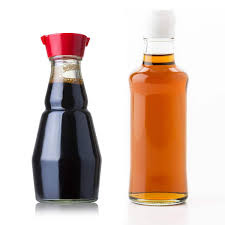When it comes to boosting flavor in your cooking, two condiments often take center stage: fish sauce and Worcestershire sauce. Both bring a distinct, savory kick to dishes, but which one’s really the best choice for your recipe? Should you reach for the bottle of fish sauce or add a splash of Worcestershire? These questions often come up in the kitchen, especially when you’re trying to elevate your culinary game. Let’s dive into the nuances of these two savory powerhouses and figure out what makes each one special.
What is Fish Sauce?
Fish sauce is a staple in many Southeast Asian cuisines, known for its umami-packed punch. It’s made by fermenting small fish, usually anchovies, with salt for months—or even years. The fermentation process breaks down the fish, resulting in a thin, dark liquid that’s rich in flavor.
How is Fish Sauce Made?
The traditional preparation involves layering fish and salt in barrels and allowing nature to do its magic. The liquid that seeps out during fermentation is collected and aged. This extended process not only gives fish sauce its depth but also intensifies its salty, briny taste.
Common Uses of Fish Sauce
Fish sauce is often used to add a savory depth to stir-fries, marinades, dipping sauces, and soups. It’s essential in dishes like Thai Pad Thai, Vietnamese Pho, and Filipino Adobo. Just a few drops can transform a dish, providing an extra layer of complexity.
What is Worcestershire Sauce?
Worcestershire sauce has a long history, originating from England in the early 19th century. It’s a versatile condiment with a base of vinegar, molasses, and tamarind, plus an array of spices and flavorings. Interestingly, it also contains anchovies, which give it a touch of fishiness.
How is Worcestershire Sauce Made?
The making of Worcestershire sauce is more complex than fish sauce. It involves fermenting the ingredients, like anchovies and onions, in vinegar before combining them with molasses, tamarind extract, and various spices. This mixture is aged for several months to create the final product that has a sweet, tangy, and savory profile.
Common Uses of Worcestershire Sauce
Worcestershire sauce adds a flavorful touch to English dishes, such as shepherd’s pie, as well as American classics like Bloody Mary cocktails and Caesar salads. It’s often used in marinades for meats and as a finishing touch to soups, stews, and dressings.
Comparing Flavor Profiles
While both sauces contain fermented fish, their flavor profiles differ significantly due to other ingredients and preparation methods.
Fish Sauce Flavor
Fish sauce has a straightforward salty, umami flavor with a strong fishy aroma. It can be quite potent, so it’s usually added in small amounts. If you’re seeking a bold umami note in your dish, fish sauce is often the go-to choice.
Worcestershire Sauce Flavor
Worcestershire sauce, on the other hand, is more complex. It balances sweetness from molasses, tanginess from vinegar, and the subtle saltiness from anchovies. Its layered flavors make it a versatile option for recipes that call for a touch of sweetness and acidity along with umami.
Nutritional Comparison
Both sauces are used in small quantities, so the nutritional differences aren’t drastic, but there are some key points to note.
Fish Sauce Nutritional Facts
Fish sauce is generally high in sodium due to the salt used in fermentation. It contains some proteins and amino acids from the fish, but it’s essentially calorie-free.
Worcestershire Sauce Nutritional Facts
Worcestershire sauce also contains a high sodium content, but it has slightly more carbohydrates due to the molasses and tamarind. It’s still a low-calorie condiment, making it suitable for various dietary preferences.
Can You Substitute One for the Other?
This is a common question: if you’re out of one, can you swap it for the other? It depends on the dish and the flavor you’re aiming for.
When Fish Sauce Works as a Substitute
If a recipe calls for Worcestershire sauce, fish sauce can be a substitute in Asian-style dishes where a robust umami punch is required. However, it won’t provide the sweetness or tanginess that Worcestershire sauce offers.
When Worcestershire Sauce Works as a Substitute
Worcestershire sauce can replace fish sauce in some recipes, especially if you’re looking to tone down the fishy taste. It’s great for marinades and Western dishes, though it may not have the same salty impact as fish sauce.
Cultural and Historical Significance
The cultural roots of these sauces go deep. Fish sauce dates back to ancient Rome, where a similar sauce called “garum” was used, while Worcestershire sauce emerged from British colonial influences.
Fish Sauce’s Role in Asian Cuisine
In Southeast Asia, fish sauce isn’t just a condiment; it’s a culinary tradition. It’s used in family recipes passed down through generations, holding a significant cultural value.
Worcestershire Sauce’s British Heritage
Worcestershire sauce reflects a blend of British and Indian influences, with ingredients like tamarind bringing a hint of the East. It’s become an essential part of British cuisine, symbolizing a colonial-era flavor.
So, Which is the Best Choice?
Ultimately, the “best” choice depends on what you’re cooking and your personal taste. If you’re preparing an Asian dish, fish sauce’s bold, salty flavor can’t be beaten. It’s perfect for adding a deep umami kick to soups, noodle dishes, and stir-fries.
However, if you need something more versatile with a mix of sweetness, tang, and umami, Worcestershire sauce might be your better bet. Its complex flavor works well in both Western and Asian-inspired dishes, especially those that benefit from a hint of acidity.
Conclusion
So, fish sauce or Worcestershire—what’s it going to be? The choice boils down to your dish’s flavor requirements. Fish sauce will give you that unmistakable umami punch, while Worcestershire sauce provides a balanced blend of sweet, sour, and savory. In some cases, a mix of both might even elevate your dish to new heights.
Experiment with both, and you’ll find that each has its own time and place in the kitchen. After all, cooking is all about playing with flavors, right?
 Diverse Perspectives: Insights & Stories Exploring Ideas, Sharing Knowledge
Diverse Perspectives: Insights & Stories Exploring Ideas, Sharing Knowledge





